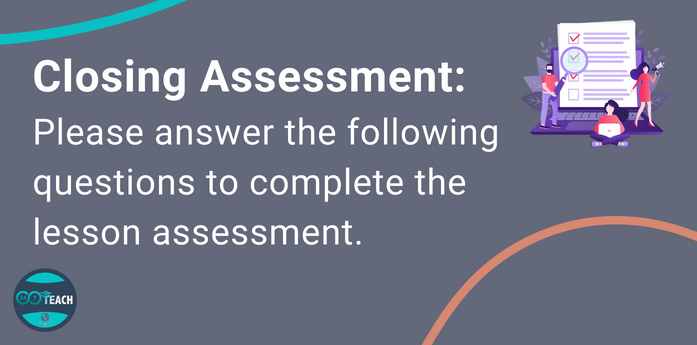Lesson 4: Integrating Sources and Avoiding Plagiarism
Prefer to listen to this lesson? Click below.
Workshop Scenario:
Please think of yourself in the following scenario as you complete this workshop:
You are a student working part-time as a writing tutor. A college student named Hannah approaches you for help.
She mentions that she is struggling with her academic writing and expresses frustration with her recent essays, which she feels are poorly structured and lack clarity. She strongly desires to improve her writing skills but feels overwhelmed by the expectations of academic writing.
As you progress through this 24/7 Teach Workshop, you gain confidence in your academic writing abilities but now feel unsure about how to use sources in your essays without copying content.
Today, you will learn how to use strategies that help integrate sources into your writing while avoiding plagiarism. Please take notes throughout the lesson, as you will need to refer to them in your closing assessment.
Lesson Objective
Your objective for today is to learn how to integrate sources and avoid plagiarism
As you read, please consider the following questions:
Provide an example of a strategy you can use to maintain your own voice when writing.
What are the key components of an effective citation, and why are they important?
Lesson 4: Integrating Sources and Avoiding Plagiarism
Academic writing requires writers to draw on a range of credible sources to support their arguments and ideas, but it can be challenging to incorporate these sources while still maintaining your own voice and avoiding plagiarism.
Whether you're a seasoned writer or just starting out, understanding how to integrate sources effectively into your writing is essential for success in academic writing.
4.1 Incorporating Sources into Your Writing
When it comes to writing papers, it's critical to incorporate sources to support your ideas and arguments. However, not all sources are created equal, and evaluating your sources' reliability is essential before integrating them into your writing.
Maintaining your own Voice
One way to maintain your voice is to use sources as a starting point for your analysis and interpretation. Rather than simply summarizing what others have said, try to build on their ideas and extend them in new directions. This can help to demonstrate your expertise and perspective while also acknowledging the contributions of others.
Another strategy is to use sources to provide evidence for your claims rather than relying on them to make the argument. By weaving sources into your own analysis and commentary, you can show that you have a deep understanding of the field and can make your own contributions to the conversation.
It's also important to pay attention to the language and style of your sources. While it's crucial to incorporate the ideas of others, you don't want your writing to become a patchwork of different voices and perspectives. To avoid this, synthesize and integrate sources into your writing in a way that is consistent with your style and voice.
Improving Clarity and Coherence
It can be challenging to maintain clarity and coherence when focusing on integrating sources with your own analyses. Here are some tips that will help elevate and preserve the quality of your writing:
Firstly, make sure to provide context for your sources. Introducing a source without any context can confuse readers and disrupt the flow of your writing. Instead, briefly summarize the source and explain why it's relevant to your argument.
Secondly, use transition words and phrases to connect your ideas and sources. Words like "however," "in addition to," and "furthermore" can help to signal to the reader how your ideas are related and build coherence in your writing.
Thirdly, try to paraphrase and summarize sources in your own words. This can help improve clarity and ensure that the source is being used to support your own argument. Be sure to give credit to the original source by citing it properly.
Finally, use direct quotes sparingly and effectively. While quotes can be a powerful way to support your argument, using too many can disrupt the flow of your writing and make it difficult for readers to follow your ideas. When using a quote, be sure to introduce it properly and explain how it supports your argument.
4.2 What is Plagiarism and Why is it Problematic?
Plagiarism is a word that strikes fear in the hearts of students and scholars alike. But what is plagiarism, exactly? Simply put, plagiarism is the act of using someone else's work or ideas without giving proper credit. It can take many forms, from copying and pasting entire passages from a source to paraphrasing without attribution.
Strategies for Avoiding Plagiarism
Avoiding plagiarism can be a tricky navigation process, but it's essential for maintaining academic integrity. Fortunately, there are several strategies you can use to ensure that you're not inadvertently plagiarizing.
Make sure to give credit to your sources. Whether using a direct quote, paraphrasing or summarizing, it's important to credit the original source by citing it properly.
Take careful notes when conducting research. Make sure to record the source and page number for any information you plan to use in your writing.
Be aware of the different types of plagiarism. Plagiarism can take many forms, from copying and pasting entire passages to paraphrasing without attribution.
Use plagiarism detection tools to check your work. Many universities and institutions provide access to plagiarism detection software that can help you identify any passages that need to be reworded or cited.
Be sure to plan your writing process carefully. Give yourself time to research, take notes, and write your paper. Rushing to complete an assignment at the last minute can increase the likelihood of accidental plagiarism.
Consequences of Plagiarism
While it may be tempting to cut corners and use someone else's work as your own, the consequences of plagiarism can be severe. In academic settings, the consequences of plagiarism can range from a failing grade on an assignment to expulsion from school.
More broadly, plagiarism can damage your reputation and credibility as a writer or scholar. When you plagiarize, you're essentially claiming someone else's work or ideas as your own, which is not only unethical but also illegal in many cases.
With the increasing availability of plagiarism detection software, it's becoming easier to catch instances of plagiarism, which can lead to significant repercussions. So if you're ever tempted to plagiarize, remember that the consequences can be severe and long-lasting. It's much better to take the time to conduct thorough research and give credit where credit is due so that you can produce high-quality, original work that you can be proud of.
4.3 Citations
Purpose of Citations
Have you ever heard the phrase "actions speak louder than words?" Well, in academic writing, citations are the action that speaks louder than words.
Citations are there to give credit where credit is due. They help you show off your research skills and demonstrate that you're a knowledgeable and credible writer. When you cite a source, you're essentially showing that the information you're using has been verified by someone else and is credible and reliable.
It's important to establish yourself as a knowledgeable and respected member of your field. One way to do this is by acknowledging the work of others and building on their ideas. Citations are a vital part of this process, as they allow you to demonstrate that you have done your research and have engaged with the work of others in your field.
By using citations effectively, you can show that you are contributing to the ongoing conversation in your field and are building on the work of others.
Comparison of Different Citation Styles
Citation styles are like the GPS for your academic writing. They guide you through the terrain of sourcing and referencing and help you stay on track by providing a framework for how to format and cite sources in your writing.
There are several different citation styles available, and choosing the right one can be challenging. In this section, we'll compare and contrast two of the more popular citation styles, MLA and APA, to help you determine which one is best for your needs.
Source: Betts, Jennifer. Difference Between MLA and APA Citation Pages. https://www.bibliography.com/mla/apa-vs-mla-citation-page/
First, let's take a look at the Modern Language Association (MLA) citation style. This style is commonly used in the humanities, particularly in English and literature courses. One of the distinctive features of MLA is that it uses parenthetical citations, which are brief references to sources in the body of the text.
These parenthetical citations include the author's name and the page number, and they're placed at the end of the sentence containing the cited information.
MLA also requires a Works Cited page at the end of the paper, which lists all the sources cited in alphabetical order by the author's last name.
Next up is the American Psychological Association (APA) citation style, which is commonly used in the social sciences. APA has a similar format to MLA, but there are some key differences.
For instance, APA uses in-text citations that include the author's last name and the year of publication rather than the page number. APA also requires a reference list at the end of the paper, which includes all sources cited in alphabetical order by the author's last name.
Try it Out!
Use one of the online citation generators below to create an MLA citation for Stephen Hawking’s “A Brief History of Time”.
In Conclusion
Integrating sources into your writing is a crucial skill that can make or break your academic success. By using effective citation styles and strategies, you can avoid plagiarism and maintain your unique voice while still incorporating the valuable ideas and information of others.
With these tips and tools in hand, you can confidently navigate the sometimes-difficult terrain of academic writing and create impactful and memorable work that will stand the test of time.
Closing Assessment:
Now that you have reached the end of this lesson, you should be able to answer the following:
Provide an example of a strategy you can use to maintain your own voice when writing.
What are the key components of an effective citation, and why are they important?
Participate in the 24/7 Discussion Forum
Please answer the following questions in the comment section below and interact with learners from around the world:
Based on your experiences, what approaches could you develop to avoid plagiarism in your writing?
Please read and reply to other learners’ answers in the forum.
Course created by: Sarah Moutaoukil, a 24/7 Instructional Design Superstar












